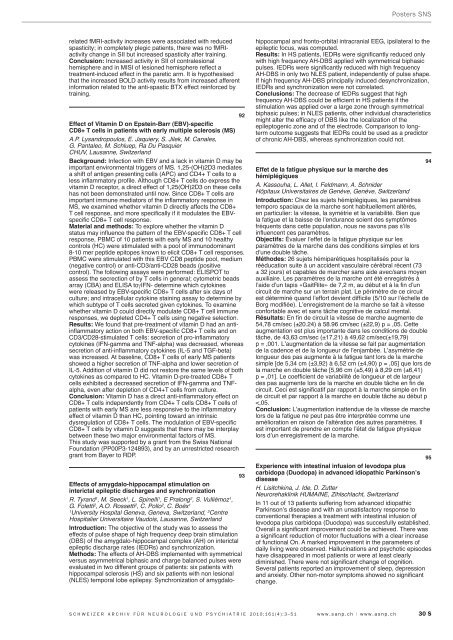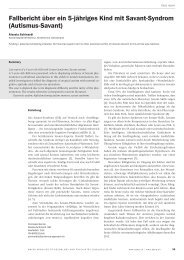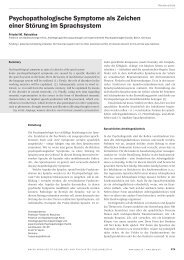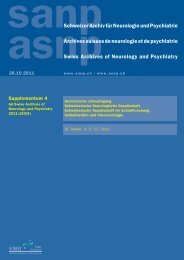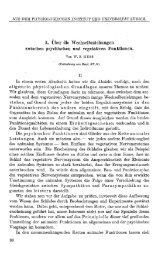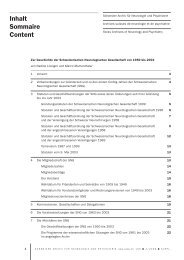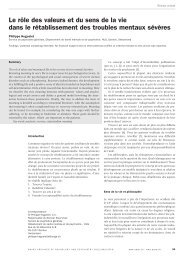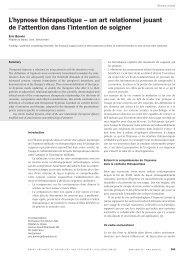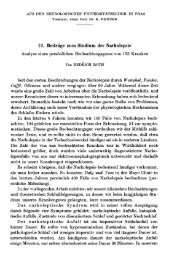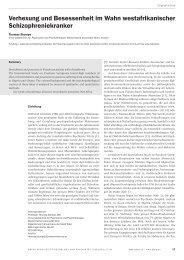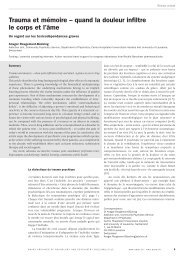Schweizer Archiv für Neurologie und Psychiatrie ... - Sanp.ch
Schweizer Archiv für Neurologie und Psychiatrie ... - Sanp.ch
Schweizer Archiv für Neurologie und Psychiatrie ... - Sanp.ch
You also want an ePaper? Increase the reach of your titles
YUMPU automatically turns print PDFs into web optimized ePapers that Google loves.
Posters SNS<br />
related fMRI-activity increases were associated with reduced<br />
spasticity; in completely plegic patients, there was no fMRIactivity<br />
<strong>ch</strong>ange in SII but increased spasticity after training.<br />
Conclusion: Increased activity in SII of contralesional<br />
hemisphere and in MISI of lesioned hemisphere reflect a<br />
treatment-induced effect in the paretic arm. It is hypothesised<br />
that the increased BOLD activity results from increased afferent<br />
information related to the anti-spastic BTX effect reinforced by<br />
training.<br />
92<br />
Effect of Vitamin D on Epstein-Barr (EBV)-specific<br />
CD8+ T cells in patients with early multiple sclerosis (MS)<br />
A.P. Lysandropoulos, E. Jaquiery, S. Jilek, M. Canales,<br />
G. Pantaleo, M. S<strong>ch</strong>luep, Ra Du Pasquier<br />
CHUV, Lausanne, Switzerland<br />
Backgro<strong>und</strong>: Infection with EBV and a lack in vitamin D may be<br />
important environmental triggers of MS. 1,25-(OH)2D3 mediates<br />
a shift of antigen presenting cells (APC) and CD4+ T cells to a<br />
less inflammatory profile. Although CD8+ T cells do express the<br />
vitamin D receptor, a direct effect of 1,25(OH)2D3 on these cells<br />
has not been demonstrated until now. Since CD8+ T cells are<br />
important immune mediators of the inflammatory response in<br />
MS, we examined whether vitamin D directly affects the CD8+<br />
T cell response, and more specifically if it modulates the EBVspecific<br />
CD8+ T cell response.<br />
Material and methods: To explore whether the vitamin D<br />
status may influence the pattern of the EBV-specific CD8+ T cell<br />
response, PBMC of 10 patients with early MS and 10 healthy<br />
controls (HC) were stimulated with a pool of immunodominant<br />
8-10 mer peptide epitopes known to elicit CD8+ T cell responses.<br />
PBMC were stimulated with this EBV CD8 peptide pool, medium<br />
(negative control) or anti-CD3/anti-CD28 beads (positive<br />
control). The following assays were performed: ELISPOT to<br />
assess the secrection of by T cells in general; cytometric beads<br />
array (CBA) and ELISA togIFN- determine whi<strong>ch</strong> cytokines<br />
were released by EBV-specific CD8+ T cells after six days of<br />
culture; and intracellular cytokine staining assay to determine by<br />
whi<strong>ch</strong> subtype of T cells secreted given cytokines. To examine<br />
whether vitamin D could directly modulate CD8+ T cell immune<br />
responses, we depleted CD4+ T cells using negative selection.<br />
Results: We fo<strong>und</strong> that pre-treatment of vitamin D had an antiinflammatory<br />
action on both EBV-specific CD8+ T cells and on<br />
CD3/CD28-stimulated T cells: secretion of pro-inflammatory<br />
cytokines (IFN-gamma and TNF-alpha) was decreased, whereas<br />
secretion of anti-inflammatory cytokines (IL-5 and TGF-beta)<br />
was increased. At baseline, CD8+ T cells of early MS patients<br />
showed a higher secretion of TNF-alpha and lower secretion of<br />
IL-5. Addition of vitamin D did not restore the same levels of both<br />
cytokines as compared to HC. Vitamin D-pre-treated CD8+ T<br />
cells exhibited a decreased secretion of IFN-gamma and TNFalpha,<br />
even after depletion of CD4+T cells from culture.<br />
Conclusion: Vitamin D has a direct anti-inflammatory effect on<br />
CD8+ T cells independently from CD4+ T cells CD8+ T cells of<br />
patients with early MS are less responsive to the inflammatory<br />
effect of vitamin D than HC, pointing toward an intrinsic<br />
dysregulation of CD8+ T cells. The modulation of EBV-specific<br />
CD8+ T cells by vitamin D suggests that there may be interplay<br />
between these two major environmental factors of MS.<br />
This study was supported by a grant from the Swiss National<br />
Fo<strong>und</strong>ation (PP00P3-124893), and by an unrestricted resear<strong>ch</strong><br />
grant from Bayer to RDP.<br />
93<br />
Effects of amygdalo-hippocampal stimulation on<br />
interictal epileptic dis<strong>ch</strong>arges and syn<strong>ch</strong>ronization<br />
R. Tyrand 1 , M. Seeck 1 , L. Spinelli 1 , E Pralong 2 , S. Vulliémoz 1 ,<br />
G. Foletti 2 , A.O. Rossetti 2 , C. Pollo 2 , C. Boëx 1<br />
1<br />
University Hospital Geneva, Geneva, Switzerland, 2 Centre<br />
Hospitalier Universitaire Vaudois, Lausanne, Switzerland<br />
Introduction: The objective of the study was to assess the<br />
effects of pulse shape of high frequency deep brain stimulation<br />
(DBS) of the amygdalo-hippocampal complex (AH) on interictal<br />
epileptic dis<strong>ch</strong>arge rates (IEDRs) and syn<strong>ch</strong>ronization.<br />
Methods: The effects of AH-DBS implemented with symmetrical<br />
versus asymmetrical biphasic and <strong>ch</strong>arge balanced pulses were<br />
evaluated in two different groups of patients: six patients with<br />
hippocampal sclerosis (HS) and six patients with non lesional<br />
(NLES) temporal lobe epilepsy. Syn<strong>ch</strong>ronization of amygdalohippocampal<br />
and fronto-orbital intracranial EEG, ipsilateral to the<br />
epileptic focus, was computed.<br />
Results: In HS patients, IEDRs were significantly reduced only<br />
with high frequency AH-DBS applied with symmetrical biphasic<br />
pulses. IEDRs were significantly reduced with high frequency<br />
AH-DBS in only two NLES patient, independently of pulse shape.<br />
If high frequency AH-DBS principally induced desyn<strong>ch</strong>ronization,<br />
IEDRs and syn<strong>ch</strong>ronization were not correlated.<br />
Conclusions: The decrease of IEDRs suggest that high<br />
frequency AH-DBS could be efficient in HS patients if the<br />
stimulation was applied over a large zone through symmetrical<br />
biphasic pulses; in NLES patients, other individual <strong>ch</strong>aracteristics<br />
might alter the efficacy of DBS like the localization of the<br />
epileptogenic zone and of the electrode. Comparison to longterm<br />
outcome suggests that IEDRs could be used as a predictor<br />
of <strong>ch</strong>ronic AH-DBS, whereas syn<strong>ch</strong>ronization could not.<br />
94<br />
Effet de la fatigue physique sur la mar<strong>ch</strong>e des<br />
hémiplégiques<br />
A. Kassouha, L. Allet, I. Feldmann, A. S<strong>ch</strong>nider<br />
Hôpitaux Universitaires de Genève, Genève, Switzerland<br />
Introduction: Chez les sujets hémiplégiques, les paramètres<br />
temporo spaciaux de la mar<strong>ch</strong>e sont habituellement altérés,<br />
en particulier: la vitesse, la symétrie et la variabilité. Bien que<br />
la fatigue et la baisse de l’endurance soient des symptômes<br />
fréquents dans cette population, nous ne savons pas s’ils<br />
influencent ces paramètres.<br />
Objectifs: Évaluer l’effet de la fatigue physique sur les<br />
paramètres de la mar<strong>ch</strong>e dans des conditions simples et lors<br />
d’une double tâ<strong>ch</strong>e.<br />
Méthodes: 26 sujets hémiparétiques hospitalisés pour la<br />
rééducation suite à un accident vasculaire cérébral récent (73<br />
± 32 jours) et capables de mar<strong>ch</strong>er sans aide avec/sans moyen<br />
auxiliaire. Les paramètres de la mar<strong>ch</strong>e ont été enregistrés à<br />
l’aide d’un tapis «GaitRite» de 7,2 m, au début et à la fin d’un<br />
circuit de mar<strong>ch</strong>e sur un terrain plat. Le périmètre de ce circuit<br />
est déterminé quand l’effort devient difficile (5/10 sur l’é<strong>ch</strong>elle de<br />
Borg modifiée). L’enregistrement de la mar<strong>ch</strong>e se fait à vitesse<br />
confortable avec et sans tâ<strong>ch</strong>e cognitive de calcul mental.<br />
Résultats: En fin de circuit la vitesse de mar<strong>ch</strong>e augmente de<br />
54,78 cm/sec (±20.24) à 58.96 cm/sec (±22,9) p = ,05. Cette<br />
augmentation est plus importante dans les conditions de double<br />
tâ<strong>ch</strong>e, de 43,63 cm/sec (±17,21) à 49,62 cm/sec(±19,79)<br />
p = ,001. L’augmentation de la vitesse se fait par augmentation<br />
de la cadence et de la longueur de l’enjambée. L’asymétrie de<br />
longueur des pas augmente à la fatigue tant lors de la mar<strong>ch</strong>e<br />
simple [de 5,34 cm (±3,92) à 6,52 cm (±4,90) p = ,05] que lors de<br />
la mar<strong>ch</strong>e en double tâ<strong>ch</strong>e [5,96 cm (±5,49) à 8,29 cm (±6,41)<br />
p = ,01]. Le coefficient de variabilité de longueur et de largeur<br />
des pas augmente lors de la mar<strong>ch</strong>e en double tâ<strong>ch</strong>e en fin de<br />
circuit. Ceci est significatif par rapport à la mar<strong>ch</strong>e simple en fin<br />
de circuit et par rapport à la mar<strong>ch</strong>e en double tâ<strong>ch</strong>e au début p<br />


